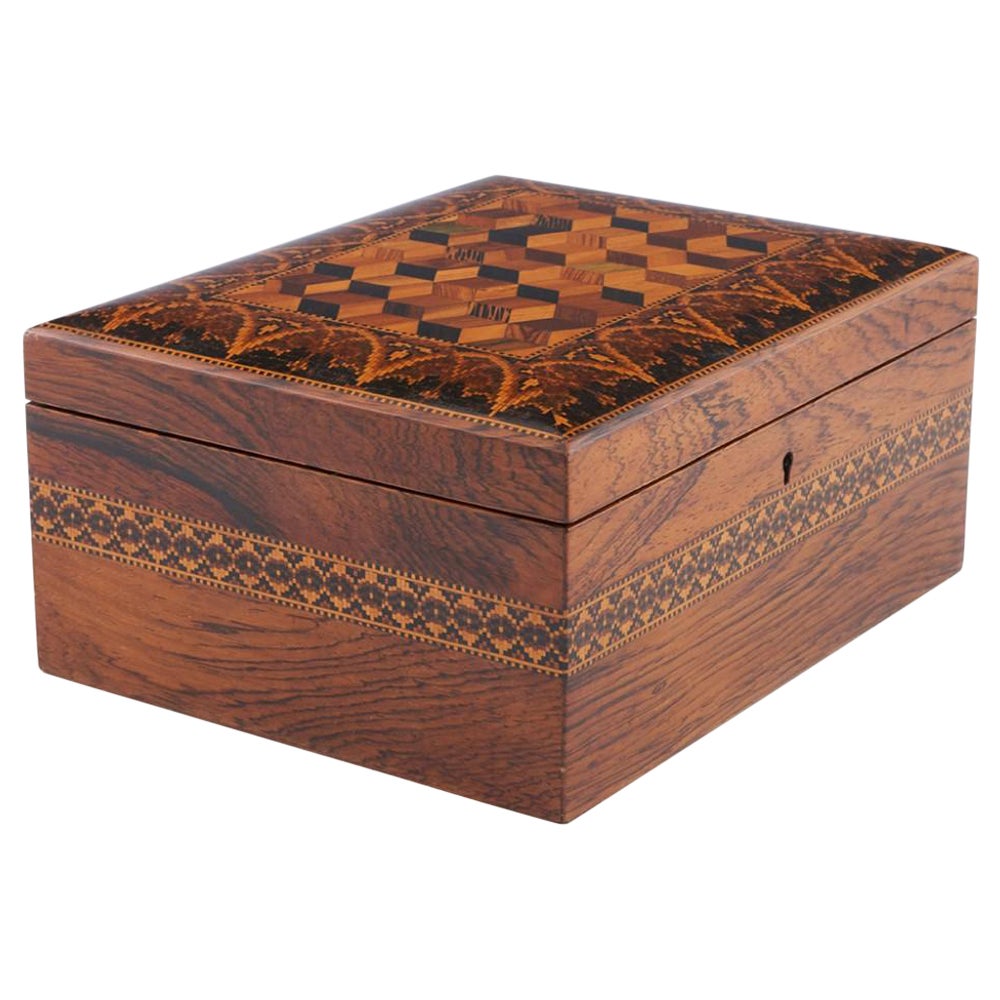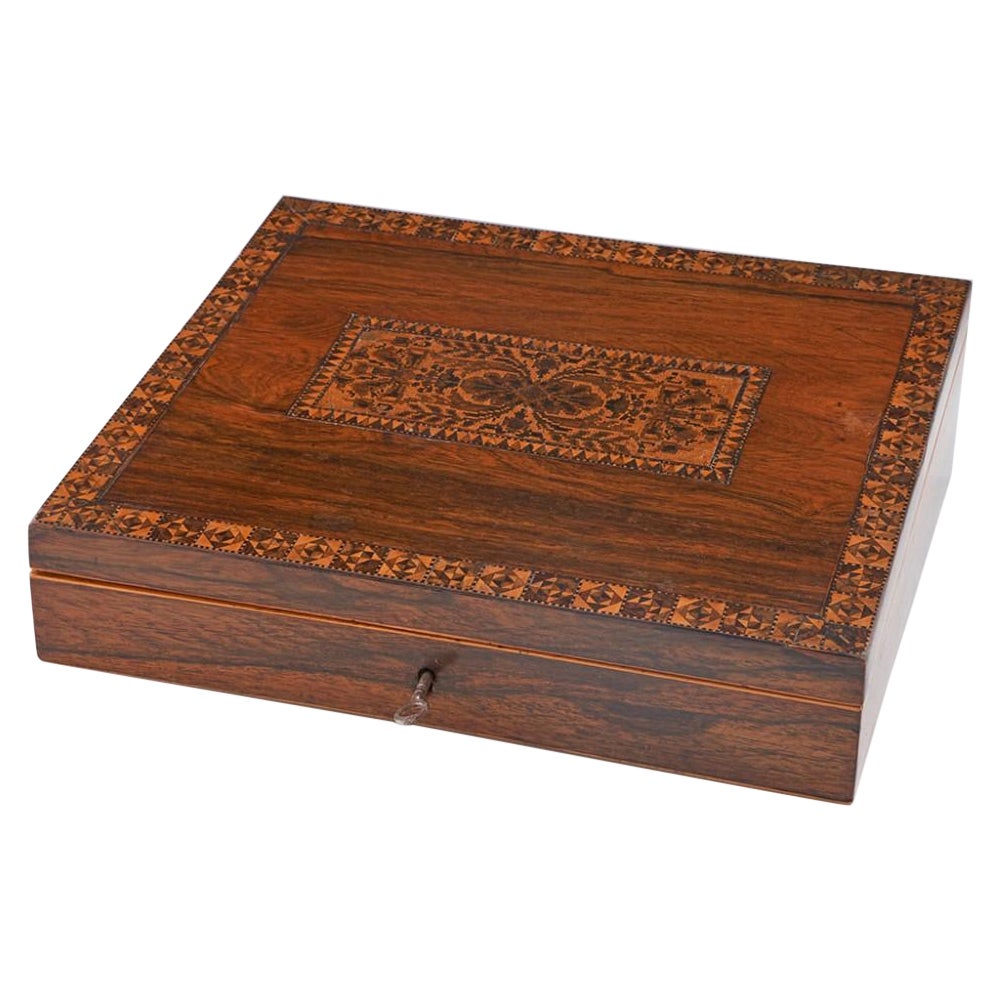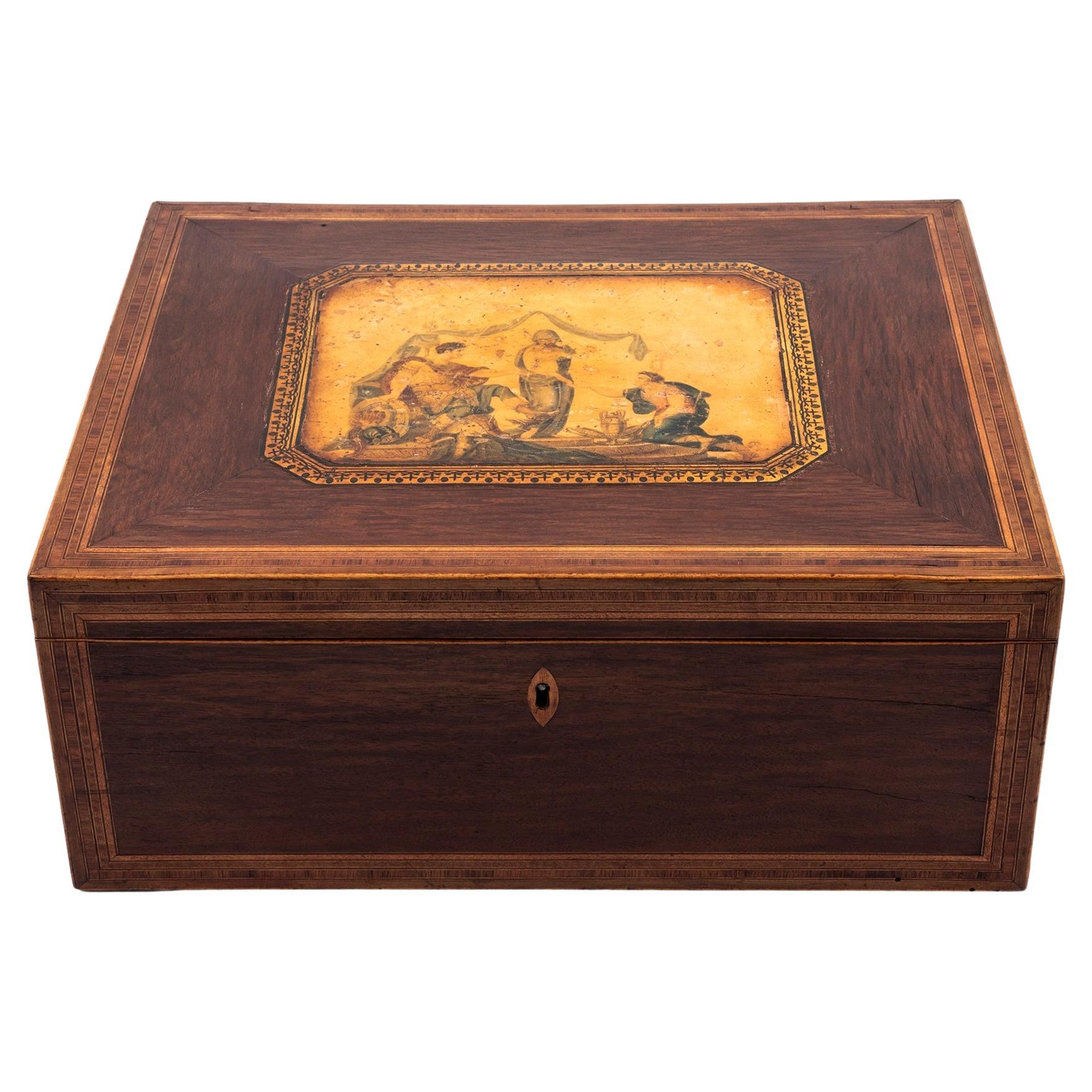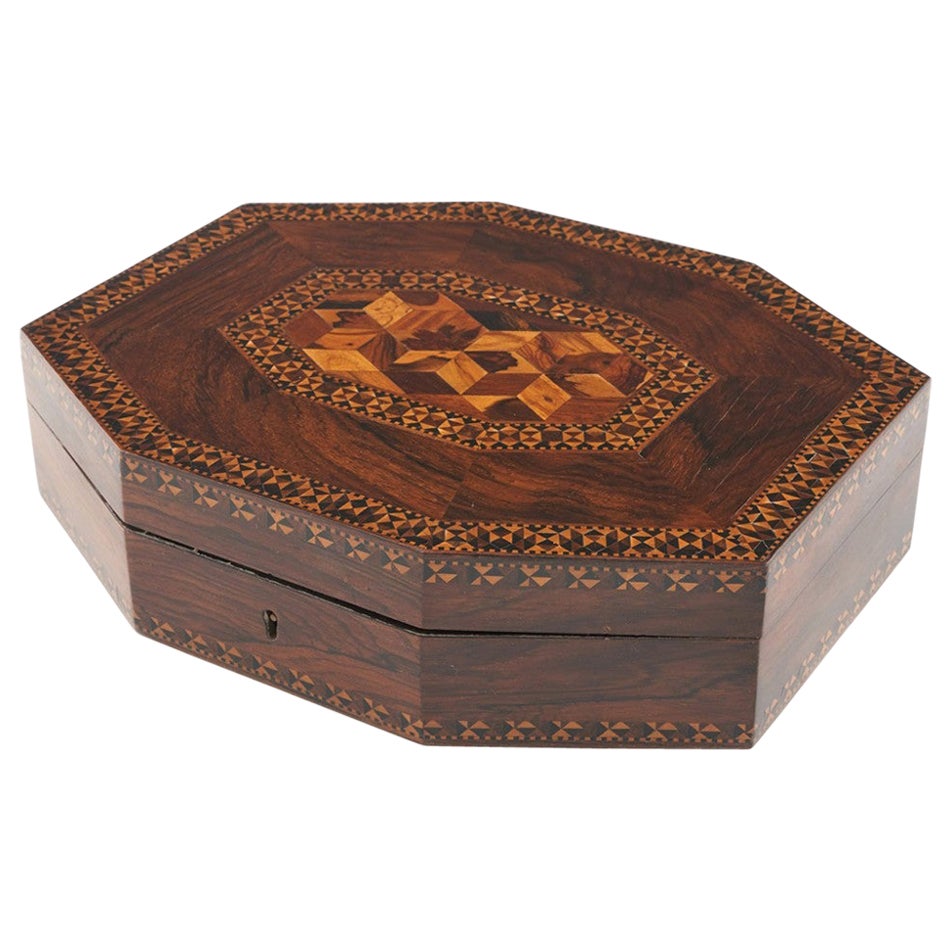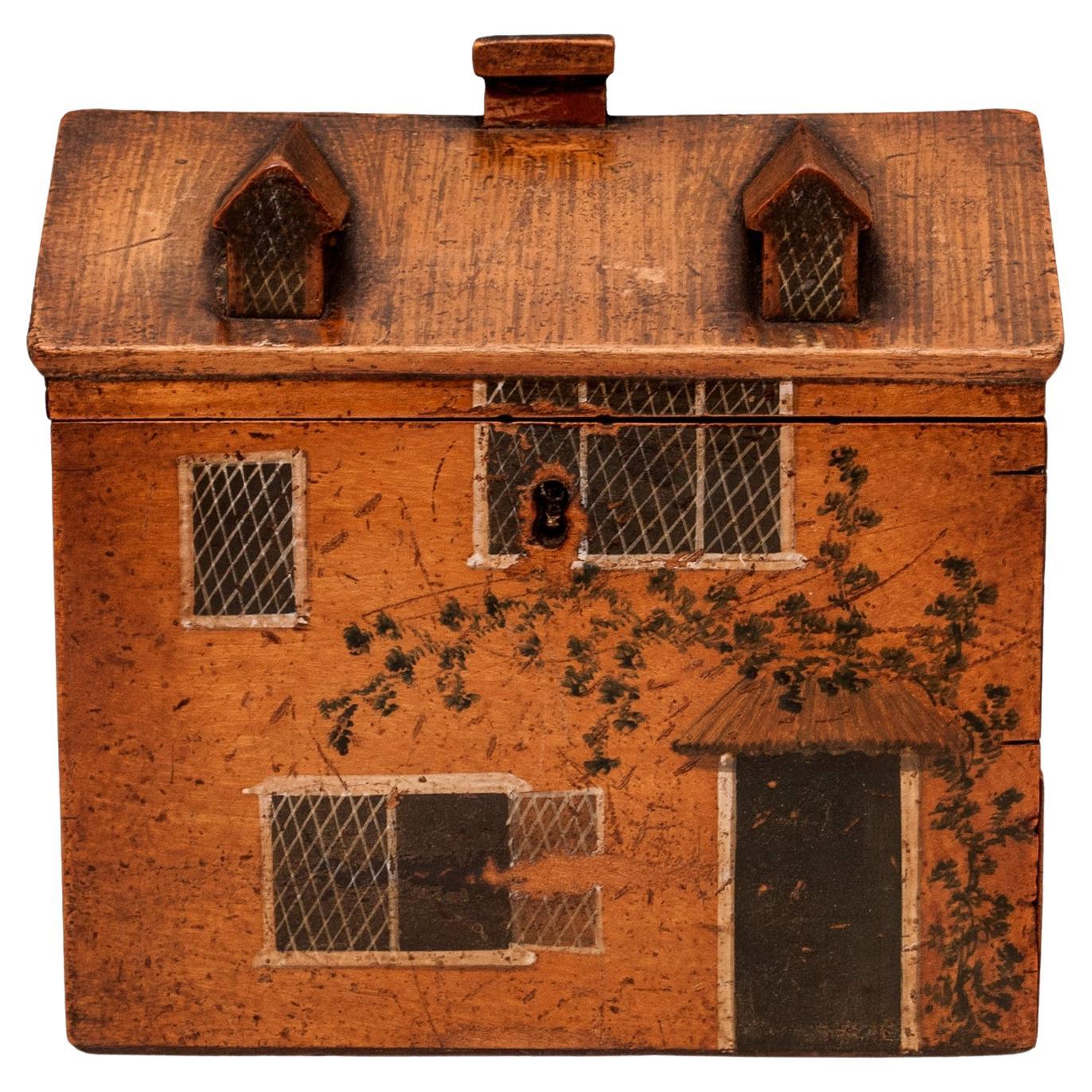Items Similar to A Sarcophagal Tunbridge Ware Sewing Box with Isometric Cube Design, c1835
Want more images or videos?
Request additional images or videos from the seller
1 of 10
A Sarcophagal Tunbridge Ware Sewing Box with Isometric Cube Design, c1835
About the Item
A Sarcophagal Tunbridge Ware Sewing Box with Isometric Cube Design, c1835
Additional Information:
Heading: Tunbridge Ware - A Sarcophagal Sewing Box with Isometric Cube Design c1835
Date : c1835
Period : William IV - Victoria
Origin : Tunbridge Wells; England
Decoration : to the lid - a small panel of isometric cubes featuring palmeira, coromandel, birds-eye maple and other veneers bounded with geometric miniature mosaic, the canted edges of the lid featuring the same, with banded keyline stringing to both. A wider mosaic band to all four sides of the rosewood body, again with keyline borders; a diamond shaped, flush fitted bone escutcheon around the keyhole; angles sides to the base, the whole sitting on four flattened bun feet; internally, a lift-out tray seated on ledged edges over the main void; the tray has sixteen compartments (with one divider missing, so should have seventeen); two of these have lift out lids with padded pin cushions affixed, one with a stitched tool-band; one box-based pin cushion, and a shaped thimble-holder; includes two small yarn cards; original rouched satin lining to the inside of the lid; replacement paper to the base; working lock and key
Size : 21.9 W x 16.6 D x 11.1 H cm
Condition : Excellent; a little crazing to the lacquer in places; one missing divider as above, wear to the lining paper where it wraps over the edges of the compartments
Restoration : re-lined base as above
Note : The use of a variety of very small, very finely grained tesserae to make up the mosaics is a signature of work produced by Humphrey Burrows, as noted by Margaret Gill and Brian Austen in their respective books.
- Dimensions:Height: 4.38 in (11.1 cm)Width: 8.63 in (21.9 cm)Depth: 6.54 in (16.6 cm)
- Style:William IV (Of the Period)
- Materials and Techniques:
- Place of Origin:
- Period:
- Date of Manufacture:circa 1835
- Condition:A little crazing to the lacquer in places; one missing divider as above, wear to the lining paper where it wraps over the edges of the compartments.
- Seller Location:Tunbridge Wells, GB
- Reference Number:
About the Seller
5.0
Gold Seller
These expertly vetted sellers are highly rated and consistently exceed customer expectations.
Established in 2014
1stDibs seller since 2023
34 sales on 1stDibs
Typical response time: 5 hours
- ShippingRetrieving quote...Ships From: Tunbridge Wells, United Kingdom
- Return PolicyA return for this item may be initiated within 30 days of delivery.
More From This SellerView All
- Tunbridge Ware - A Fine Sewing Box with Isometric Cubes, c1850By Edmund Nye Tunbridge WellsLocated in Tunbridge Wells, GBTunbridge Ware - A Fine Sewing Box with Isometric Cubes and Geometric Mosaics, c1850 Additional Information: Heading: Tunbridge Ware - A Fine Sewing Box with Isometric Cubes and Geo...Category
Antique 19th Century English Victorian Decorative Boxes
MaterialsOak
- Tunbridge Ware - An Early Writing Slope with Geometric Designs, c1835By Edmund Nye Tunbridge WellsLocated in Tunbridge Wells, GBTunbridge Ware - An Early Writing Slope with Geometric Designs, c1835 Additional Information: Heading: Tunbridge Ware - An Early Writing Slope with Geometric Designs Date : c1835 ...Category
Antique 19th Century English William IV Decorative Boxes
MaterialsRosewood
- Tunbridge Ware Stationery Box with Isometric Cubes and Floral Mosaic, c1870Located in Tunbridge Wells, GBTunbridge Ware Stationery Box with Isometric Cubes and Floral Mosaic, c1870 Additional Information: Heading: Tunbridge Ware - Wedge-Shaped Stationery Box with Isometric Cubes and Fl...Category
Antique 19th Century English Victorian Decorative Boxes
MaterialsPaper
- Tunbridge Ware Sewing Box c1840By Tunbridge WareLocated in Tunbridge Wells, GBHeading : Tunbridge ware sewing box Date : c1840 Period : Victoria Origin : Tunbridge Wells, Kent Decoration : Central perspective cube patte...Category
Antique 1840s British Victorian Decorative Boxes
MaterialsWood
- Tunbridge Ware - A Very Finely Decorated Sewing Box, c1840Located in Tunbridge Wells, GBTunbridge Ware - A Very Finely Decorated Sewing Box with 'Hurst Wood Cottage' Mosaic, c1840 Additional Information: Heading: Tunbridge Ware - A Very Finely Decorated Sewing Box with...Category
Antique 19th Century English Victorian Decorative Boxes
MaterialsPaper
- Tunbridge Ware Sewing Box with Eridge Castle Topographic Mosaic, c1860Located in Tunbridge Wells, GBTunbridge Ware Sewing Box with Eridge Castle Topographic Mosaic, c1860 Additional Information: Heading: Tunbridge Ware - A Sewing Box with E...Category
Antique 19th Century English Victorian Decorative Boxes
MaterialsSatinwood
You May Also Like
- Regency Tunbridge Ware Sewing BoxBy Tunbridge WareLocated in Northampton, GBFitted Interior & Silver Handles From our Tunbridge Ware collection, we are delighted to offer this Tunbridge Ware Sewing Box. The Sewing Bo...Category
Antique Early 19th Century British Regency Decorative Boxes
MaterialsSatinwood
- Georgian Tunbridge Ware Folk Art Cottage Sewing BoxBy Tunbridge WareLocated in Northampton, GBTunbridge Ware Folk House Sewing Box From our Sewing Box collection, we are thrilled to offer this Novelty Folk Art Cottage Sewing Box. The box of rectangular form made from Sycamor...Category
Antique Early 1800s British Georgian Decorative Boxes
MaterialsWood, Sycamore
- Tunbridge Ware BoxLocated in Dallas, TXLarge Tunbridge ware box with herringbone pattern inlaid parquetry. Circa 1840, England.Category
Antique 1840s English Decorative Boxes
MaterialsWood
- Brighton Pavilion Tunbridge Ware Sewing CompendiumBy Tunbridge WareLocated in Northampton, GBRare Tunbridge Ware Form Sewing Compendium From our Tunbridge Ware collection, we are delighted to offer this very rare Tunbridge Wear Sewing Compendium. The Sewing Compendium modelled as a tower from the Brighton Pavilion features the iconic minaret turned in Sycamore (aka white wood) and a large globular body with hand-painted details leading to further turned faces and the hand-painted windows upon a stepped base. The Sewing Compendium opens in two locations one just below the first dome revealing a pin cushion and the second just above the windows revealing the Sewing tools including a Tunbridge Ware thimble and bobbin. The Tunbridge Ware Sewing Compendium dates to the Georgian era during the reign of George IV circa 1825. Brighton Pavilion, The Royal Pavilion and surrounding gardens are a Grade I listed property and were the former Royal residence located in Brighton, England. It was built in 1787 in three stages as a seaside retreat for George, Prince of Wales who became the Prince Regent in 1811 and then King George IV in 1820. It is built in the Indo-Saracenic style prevalent in India for most of the 19th century. The current appearance of the Pavilion which has various domes and minarets, is the work of architect John Nash, who extended the building starting in 1815. George IV's successors William IV and Victoria also used the Pavilion but Queen Victoria decided that Osborne House should replace the Pavilion as the royal seaside retreat and therefore the Pavilion was sold to the city of Brighton in 1850. Indo-Sarascenic refers to a cross between Indian architecture and Muslim architecture. Minarets means beacon in Arabic. In Islamic religious architecture, the tower from which the faithful are called to prayer five times each day by a muezzin, or crier. Such a tower is connected to a mosque and has one or more balconies or open galleries. The inspiration for the minarets features on the Brighton Pavilion are in homage to these types of finials. John Nash (1752-1835) was one of the most prevalent British architects from the Georgian and Regency periods. He was responsible for the design, in the neoclassical and picturesque styles of many important areas of London. He was financed by the Prince Regent and by the era's most successful property developer, James Burton. Nash's most famous designs were the Brighton Pavilion, Marble Arch and Buckingham Palace. Sycamore is a member of the Maple family, found in Europe. It is light yellow in colour and is often a very clean wood, with a straight, fine grain. The wood is often pippy. However, these pips are usually a very similar colour to the rest of the wood making them hardly visible. Georgian, a period in British history dating from 1714-1837, the Georgian era after the Hanoverian kings George I, George II, George III and George IV. Tunbridge Ware Tunbridge Wells and Tunbridge in Kent, England became popular in the 17th Century for their therapeutic waters. By the 18th century, Tunbridge Wells was a hugely popular Spa resort. Shops and stalls were set up to sell local work of distinction to visitors as souvenirs. Many of the original boxes were decorated with all sorts of different kinds of designs. Many of the Tunbridge boxes...Category
Antique Early 19th Century British George IV Decorative Boxes
MaterialsWood, Sycamore
- English William IV Stickware Tunbridge & Rosewood Stationery Box c.1835Located in Bath, GBA handsome piece of early Tunbridge Ware dating to around 1835, William IV in era. Made from wood this small stationery box is decorated with intricate Tunbridge Stickware inlay. The interior has been professionally re-lined in a handsome hand-marbled paper; the size of the interior would suit...Category
Antique 1830s British William IV Decorative Boxes
MaterialsWood
- Lovely antique Victorian tunbridge ware inlaid writing boxLocated in Ipswich, GBLovely antique Victorian tunbridge ware inlaid writing box having a lovely antique Victorian tunbridge ware inlaid wring box with beautiful detail to the box opening to reveal a pull...Category
Antique Early 19th Century Victorian Decorative Boxes
MaterialsWood
Recently Viewed
View AllMore Ways To Browse
Bohemian Glass Casket
Armor Plates Portugal
Silverware Box Gorham
Chase Reimann
Harden Bedroom Furniture Brass Handles
Lonka Lonka
Gold And Wood Box
Vizagapatam Ivory
Lucite And Chrome Box
English Chinoiserie Box
Bronze Box
Alessandro Mandruzzato Murano Glass Box
Russian Paper Mache Box
18th Century Bible Box
Porphyry Box
Singing Bird Box Automaton
Poker Chips Clay
Red Mother Of Pearl Vanity
